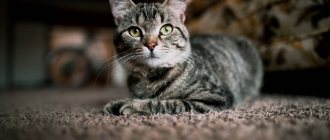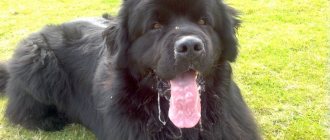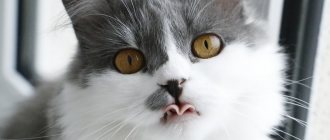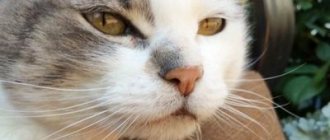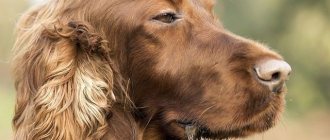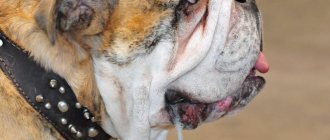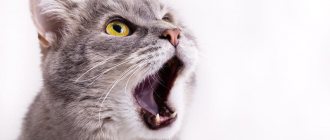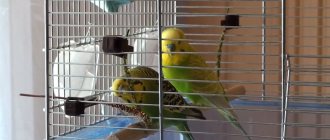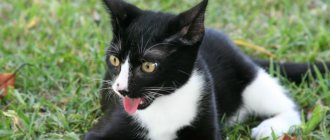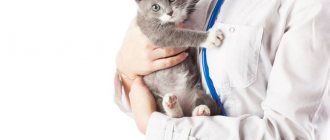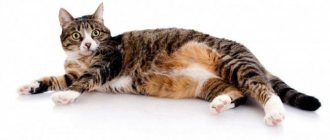Home » Useful Information
Increased salivation in cats can appear for completely harmless reasons, but in some cases the provocateur becomes a pathology that requires mandatory treatment. When such a clinical picture occurs, competent differential diagnosis is important, which will help to identify the disease in the pet at the initial stage.
- 2 Causes of hypersalivation
2.1 The main causes of hypersalivation in cats - video
- 4.1 Drugs that are used to eliminate the causes of hypersalivation - photo gallery
How does hypersalivation manifest?
Normal salivation in cats is called salivation, and increased salivation is called hypersalivation. If there is a deviation from the norm, you need to pay attention to the accompanying symptoms.
Normal salivation
First of all, saliva is needed to moisten the food being absorbed. Severe drooling is observed in cats eating dry food. This is absolutely normal. Saliva moistens the dry granules, making them easier to swallow and pass through the esophagus. It also performs a protective function: it disinfects swallowed pieces of food, prevents damage to tooth enamel and oral mucosa.
Hypersalivation in a kitten occurs when baby teeth erupt. With the advent of a full combat set, it stops by itself.
With normal drooling in cats, the fur around the mouth becomes slightly wet. If saliva drips constantly, worsening the quality of the coat, and its volume gradually increases, consult a doctor. This situation requires mandatory diagnosis.
Abnormal salivation
In addition to the deterioration in the quality of fur on the face, neck and chest, the owner should be alert to other alarming symptoms:
- the formation of wet marks in the place where the pet sleeps;
- the tongue falling out of the mouth, which occurs due to its lethargy;
- increasing the number of daily washes;
- making frequent swallowing movements.
In the presence of pathology, hypersalivation is complemented by concomitant symptoms. The patient's appetite decreases, apathy or increased excitability appears. If the condition worsens, gastrointestinal disorders (vomiting, diarrhea), fever and cough may occur.
Kidney failure
Kidney failure can manifest itself in acute or chronic conditions. Cats with chronic renal failure (CRF), also called chronic kidney damage, often exhibit clinical signs of increased thirst, weight loss, dilute urine, increased urination (manifested as large collections in the litter box), halitosis, and drooling. .
This condition occurs when the kidneys are unable to remove waste products, creatine and BUN from the body. As these wastes accumulate in the bloodstream, they create uremic ulcers in the stomach, mouth, and esophagus. A veterinarian often treats kidney disease by:
- Medicines
- Intravenous fluids
- Blood work monitoring
- Stomach protection
- Low protein diet
Causes not related to illness
The causes of increased salivation in a cat are not related to breed. Hypersalivation occurs not only in purebred pets, but also in mixed breeds. In most cases, it is explained by physiology and does not require treatment.
Taking a bitter medicine or licking a chemical substance
When taking bitters orally, an unpleasant taste occurs in the mouth, accompanied by slight numbness. In an attempt to get rid of bitterness, the salivary glands begin to work in enhanced mode. The amount of fluid released and the duration of its flow are individual. On average, the process takes no more than 20 minutes. With long-term use of medications, hypersalivation occurs not only after swallowing the substance, but also shortly before.
It is better to avoid licking chemicals. In this case, excessive salivation is the most favorable outcome. Frequent contact with household chemicals or other hazardous substances can result in serious intoxication.
If your pet licks a package of toilet cleaner right in front of your eyes, then most likely nothing will happen to him. To be safe, watch him for a while and be sure to hide the chemical away from his eyes and agile paws.
Motion sickness while traveling
Animals, like people, are not immune to motion sickness in transport. In addition to increased salivation, nausea and vomiting may occur during the trip. All of the above symptoms disappear on their own at the end of the trip.
Anesthesia
The work of the salivary glands slows down during natural sleep and similar conditions caused artificially. Soon after waking up from anesthesia, the animal experiences increased production of saliva. After replenishing the required volume of fluid, the work of the glands returns to their usual rhythm.
Great hunger
If a cat drools regularly, then the reason for this phenomenon is quite simple. When feeding hourly, the animal's biological clock signals that food is about to be taken. The feeling of hunger intensifies, and a thin stream of saliva appears from the mouth.
Try to avoid taking too long breaks, as real hunger stimulates the production of gastric juice. Due to increased acidity, your pet may develop erosion or ulcers.
Excess of affection
Hypersalivation is typical for affectionate pets that “melt” under the owner’s stroking. When reaching maximum pleasure, they not only purr loudly, but also drool. Most often, this feature is found in sphinxes and orientals.
Foreign object in teeth
The cause of excessive salivation in a cat may be a foreign object stuck in the teeth. If your pet constantly licks itself, carefully examine its oral cavity. In the absence of an abscess and inflammation, a stuck bone, piece of food or other foreign object can be removed with ordinary tweezers.
If there is a decrease in appetite, frequent coughing or vomiting, it is better to consult a veterinarian. The appearance of blood, the main symptom of internal damage, is especially dangerous. Surgery may be required to save the cat.
Old age
With age, bones become more fragile. First of all, this affects the teeth. They wear out and fall out faster. Because of this, the gums are more vulnerable and are often affected by pathogens. To prevent the inflammatory process, the salivary glands begin to work in enhanced mode.
Cats over 12 years old often suffer from caries, gingivitis and periodontal disease. To maintain the health of their teeth, it is necessary to regularly maintain oral hygiene and undergo a preventive examination at the veterinary clinic at least 2 times a year.
Diagnostic methods
Diagnostic methods used to identify the provoking factor:
- Inspection. The doctor determines the condition of the gums, teeth, larynx, and skin. With allergies, rashes are often observed, and the presence of inflammatory processes can be understood by reddened and swollen tissues in the oral cavity. The veterinarian also feels the abdominal cavity. If the pet reacts violently to the procedure, then the presence of gastrointestinal diseases can be suspected.
- Ultrasound. Ultrasound examination is used to identify foreign bodies and tumors in the abdominal cavity. This method is completely safe and painless for the animal.
- Blood, urine and stool tests. An increase in leukocytes and red blood cells in plasma indicates an inflammatory process. Also, such deviations may indicate the presence of tumors. Protein can be detected in the urine, indicating a malfunction of the urinary system, an inflammatory process, as well as salts, the increase of which indicates the presence of kidney stones. Bacteria present during an infectious process may be found in urine. Stool analysis is necessary to identify helminthic infestations.
- MRI. Magnetic resonance imaging is an expensive research method, thanks to which it is possible to determine disturbances in the functioning of internal organs, as well as the presence of tumor processes. This procedure requires preliminary sedation (injection of sleeping pills) of the pet so that it does not move or run away during the examination.
Ultrasound allows you to identify pathologies of the pet’s internal organs
An integrated approach to diagnosis allows you to obtain an accurate result based on a number of studies. In this case, pathology can be detected in the early stages of development.
Pathological causes
It is worth thinking about pathology if hypersalivation occurs at different times of the day and lasts more than 2 hours with a stable increase in saliva volume. Based on the accompanying symptoms, you should try to make a preliminary diagnosis yourself, since one of the possible causes is fatal to humans.
Virus: rabies, calcivirosis, rhinotracheitis
Drooling in cats occurs when infected with viruses. Depending on the symptoms, the pet may be infected:
- Rabies
. The most dangerous infection, accompanied by behavioral changes, photophobia and hydrophobia. If the disease occurs in a violent form, then the infected person can attack the owner. Any bite or scratch received from a carrier of the virus is deadly. Before the veterinarian arrives, be sure to isolate the cat in a separate room and do not come into contact with it.
- Calcivirus
. Severely weakens the body. Accompanied by vomiting, inflammation of the conjunctiva, stomatitis and damage to the respiratory system. May cause lameness and pneumonia. Treatment of the disease comes down to preventing secondary infection, which increases the likelihood of death to 80%. Additionally, symptomatic therapy is carried out to increase the immune response. As a result, the body destroys the virus on its own.
- Rhinotracheitis
. Causes depression and loss of appetite. The patient's temperature rises, rhinitis, cough and shortness of breath appear. Discharge from the eyes and nose may contain pus. Treatment is carried out by analogy with calcivirus. Without timely treatment, the disease develops into a chronic form. After recovery, 80% of whiskered patients remain carriers of the virus, so it is important to prevent them from coming into contact with other animals.
Please note that there is no cure for rabies. The only way to help a mustachioed pet is to prevent it from becoming infected. Preventive recommendations and vaccination will help with this.
Oncology – leukemia
Leukemia, or blood cancer, is a deadly pathology of the hematopoietic system. As a result of the proliferation of tumor tissue, healthy cells are replaced by malignant ones. The patient's immunity is suppressed, increasing the body's vulnerability.
The main danger of this disease is the absence of external signs. Blood cancer can be detected only by symptoms of secondary infections. The oral cavity is most often affected. The animal develops gingivitis and stomatitis, accompanied by abundant salivation.
Despite the lack of effective treatment, timely therapy prolongs the patient's life while maintaining his quality of life. In addition to a special diet, veterinarians use antibiotics, antiviral drugs and immunomodulators. In severe cases, a blood transfusion is required.
The cat is about to vomit fur
Periodic hair shedding is a natural process. Some owners specifically give their pets fresh grass that stimulates the gag reflex. As a result of burping, small balls of hair, or trichobezoars, come out of the cat's mouth.
Pathology is indicated when hairballs accumulate in the intestines. The resulting mass blocks the passage of feces, causing constipation, vomiting of undigested pieces of food and profuse salivation. Without timely help, the animal may die from rupture of the intestinal walls.
For treatment, medications are used that dissolve accumulated hairs and a special diet that normalizes digestion. Surgery is resorted to only in case of intestinal obstruction, when any stimulation of peristalsis is lethal for the patient.
Poisoning and nausea
Drooling, accompanied by frequent vomiting and diarrhea, is often associated with poisoning. Ingesting spoiled food, cleaning products, human medicines, or toxic plants can cause laryngeal muscles to spasm. If your cat's breathing is interrupted and his heartbeat increases, take him to the veterinary clinic immediately. Acute poisoning can be fatal.
To remove toxins, rinsing is used, but in case of poisoning, an antidote must first be administered. Otherwise, the condition of the mustachioed patient will worsen. After toxins are removed, the animal is prescribed infusion therapy and a gentle diet.
Oral diseases
With untreated caries, the animal develops gingivitis, that is, inflammation of the gums. In addition to increased work of the salivary glands, this pathology is accompanied by severe redness of the gums. An unpleasant odor may also appear.
Another possible cause of hypersalivation is a mucocele, or salivary gland cyst. With this disease, a blockage occurs in the duct of the salivary glands. The accumulating fluid leads to severe swelling.
Oral diseases left untreated can lead to tooth loss. Depending on the diagnosis, the veterinarian prescribes antibiotics, anti-inflammatory drugs, pain-relieving gels, or more radical methods of therapy. In advanced cases, diseased teeth are removed. This operation is performed under general anesthesia.
Infection with worms
The cat drools even with helminthiases. Infection is accompanied by loss of appetite and weight, bloating and hardening of the abdomen. Helminth waste products cause severe intoxication. The body uses vomiting and diarrhea to get rid of harmful substances. These symptoms are very dangerous for kittens - they can die due to dehydration.
Anthelmintic drugs are used for treatment. The medicine is given twice, as it does not affect the parasite eggs. Repeated administration of the anthelmintic kills the hatched larvae, preventing the next laying of eggs.
Allergy
Allergic reactions are accompanied by itching, redness of the skin, rhinitis and cough. Frequent interaction with an allergen is fraught with the development of bronchial asthma. It is better to show an animal with suspected allergies to a veterinarian. Antihistamines are used to suppress the effect of the allergen.
Gastrointestinal pathologies
If your cat is drooling, mucous membranes have turned yellow, vomiting and diarrhea have appeared - pay attention to inclusions in the feces and vomit. The presence of foreign inclusions (blood, mucus, pieces of undigested food) and a putrid odor from the mouth are the main symptoms of gastrointestinal pathologies: enteritis, pancreatitis, gastritis, colitis. All these diseases are dangerous not only due to dehydration, but also due to the failure of the diseased organ.
The type of therapy depends on the diagnosis, but in all cases it is recommended to follow a therapeutic diet. If necrosis is detected, surgery is performed to remove damaged tissue.
Reaction to stress
Prolonged nervous tension reduces the body's defenses, exacerbating chronic diseases and increasing susceptibility to infections. It is caused by travel in transport, visits to the veterinary clinic, moving and other alarming events for the animal. In addition to drooling, stress is accompanied by slight trembling, restlessness, active licking and avoidance of contact with the owners.
In addition to eliminating the irritating factor, veterinarians recommend calming medications with pheromones. They are produced in the form of drops, collars and diffusers with replaceable bottles.
Caustic poisons
Cats cannot metabolize chemicals and medications well. This is due to their altered metabolism in the liver, called glucuronidation.
Corrosion from chemicals (washing detergents, floor cleaners, weed killers, etc.) can cause burns to the mouth, tongue, esophagus and stomach. If swallowed, they can cause poisoning and severe drooling.
If you suspect that your cat has recently been exposed to a caustic chemical, you should rinse her mouth with water. After rinsing, offer your cat something she will enjoy drinking, such as chicken broth. This will flush the esophagus and loosen the toxin in the mouth.
What should the owner do?
Possible actions on the part of the owner depend on the condition of the animal. If it is healthy, and all the signs of a physiological cause are present, the problem that has arisen will resolve itself.
If you are prone to motion sickness in transport, consult your veterinarian to select tablets. Give them to your cat before every trip.
An object stuck in the teeth should be carefully removed with tweezers. After manipulation, treat the mucous membranes with Miramistin or chlorhexidine to avoid infection. If the foreign body is deeply located, it is better not to take independent actions, since any mistake can lead to injuries to the larynx.
In all other cases, it is recommended to immediately contact a veterinarian. Remember that when infected with certain viruses and helminths, a cat becomes dangerous to humans.
The cat is drooling from his mouth: what to do at home, prognosis of the course of the disease
Our recommendations apply only to home care after visiting a veterinarian.
Hypersalivation in cats is a dangerous symptom, and you cannot help your pet yourself - it can only worsen the situation.
First of all, be sure to call your doctor and take any measures only on the basis of consultation.
During your visit to the clinic, all necessary treatment, medications, care and feeding regimen will be prescribed by your doctor. It is necessary to strictly follow the instructions and regularly contact the veterinarian.
The prognosis depends greatly on the disease that has been diagnosed.
If your cat is suspected of having rabies, it must be quarantined at the Animal Disease Control Station.
Dental problems are usually solved with surgery and cleaning of the mouth. Your doctor may prescribe special medications for home care.
Recovery from poisoning depends largely on how quickly the poisoning was identified and what substance caused it.
The prognosis for kidney and liver disease is guarded and lifelong treatment is often required.
When diagnosing a malignant tumor, the prognosis depends on the type of tumor.
In what cases does an animal require treatment?
Treatment is required for any pathological cause, since self-healing is an extremely rare phenomenon. To determine the necessary medications, the pet will have to undergo tests and undergo all examinations recommended by the doctor.
Do not delay contacting the veterinary clinic if alarming symptoms are detected. Timely treatment begins significantly reduces the risk of developing possible complications.
Poisonous plants
According to Mark S. Thompson, plants containing insoluble calcium oxalate crystals can cause a severe burning sensation in the mouth if your cat accidentally ingests them. Plants that are poisonous to cats include:
- Peace Lily
- Calla Lily
- elephant ear
- Dieffenbachia
- umbrella plant
- mother in law tongue
Insoluble calcium oxalate in plants causes minimal toxicity in cats, but can cause unpleasant reactions. If you have one of these plants and you suspect a cat has gotten into it, rinse its mouth with water and then give the broth.
Preventive measures
To prevent symptoms of hypersalivation in your pet, you must follow a number of simple rules:
- Store toxic substances in places inaccessible to animals and children.
- Limit your cat's access to poisonous house plants.
- Regularly inspect the cat's oral cavity to catch the development of infection at the first stage.
- Check your pet's diet for sharp or overly hard lumps of food.
- When treating for external parasites, the substance should be dripped onto places where the cat cannot reach with its tongue (on the scruff of the neck).
- Conduct timely vaccination of the animal against dangerous infections.
- Bring your pet for a veterinary examination annually.
We must not forget that if alarming signs appear, only a qualified medical specialist can make a correct diagnosis.
Signs of excessive drooling
The presence of food or any irritant in the cat's mouth causes the production of saliva. Sometimes increased secretion of glands occurs for other reasons. You can notice the manifestation of drooling by characteristic factors in your pet’s behavior:
- often rubs its muzzle on the corners of furniture to get rid of accumulated excess;
- the cat often swallows and rubs its muzzle with its paw;
- The pet's tongue seems to fall out of the mouth and becomes flaccid.
Cat drooling
Drools flow in different ways:
- actively in streams or drops;
- slowly, imperceptibly at first glance.
An observant owner will notice the appearance of dampness in the places where the animal sleeps, the accumulation of wet fur, “icicles” on the pet’s neck and paws.
Consequences of self-medication
Lost time to provide assistance often causes complications and sometimes death of pets.
Most diseases do not go away on their own. It is necessary to treat with medications, the selection and dosage of which is prescribed only by a specialist. Inflammatory processes without proper attention shorten life. So, without treatment, gingivitis becomes chronic, the cat loses teeth, and digestion is impaired. Pain and frustration spoil the character of the animal.
The entry of foreign objects into the stomach and intestines leads to necrosis and tissue rupture. Waiting for the cat to get rid of the load on its own is dangerous.
Visiting the Veterinarian
Increased drooling is not always a harmless phenomenon. It is not always possible to cope with the problem without the help of a doctor.
Prevention measures
It is easier for a sensitive owner to prevent many problems by being attentive to the pet. Veterinarians recommend:
- monitor the cat's diet;
- exclude bones from the diet;
- carry out timely antiparasitic treatments;
- comb out pets' fur during shedding;
- use special toys to clean your cat's teeth;
- follow vaccination schedules;
- remove household chemicals from pets;
- monitor the condition of your teeth and mouth.
Prevention of cat diseases is directly related to regular visits to the veterinarian. The appearance of excessive saliva in a pet is a serious reason to examine the animal.
Veterinarian help
If there is sudden drooling, profuse discharge, or other signs are observed, then the animal needs urgent medical attention.
Alarming symptoms of drooling:
- inappropriate behavior of a pet;
- no reason for stress;
- changes in the volume of saliva produced during the day;
- drooling for more than 1.5 hours;
- the situation is getting worse.
The animal's oral cavity is first examined to rule out non-viral diseases.
Functions of saliva
Saliva is a secretion that can be watery if it comes from the serous glands, or viscous if it comes from the mucous glands. It contains up to 99.5% water. In addition, the composition includes:
- electrolytes – anions and cations;
- proteins in small quantities;
- mucin
Saliva performs the following functions:
- protects teeth, gums and oral mucosa from damage;
- softens food, makes it easier to chew food;
- extracts flavor elements from food;
- helps the formation of a food coma, which is easier to swallow;
- is able to disinfect and stop bleeding due to the presence of thromboplastic components in the composition.
Dangerous infections
Diseases in this category are characterized by an acute course.
Excessive salivation is one of the few symptoms accompanying the pathology.
Worm infestations
A large accumulation of parasites in the intestines of an animal leads to poisoning of the body and disruption of the digestive system.
Feline viral leukemia
Causes of occurrence: when the membranes of the digestive and respiratory organs become inflamed, retroviruses suppress the cat’s immune system, which leads to the development of stomatitis, gingivitis, lymphadenitis, resistant to therapy, and neoplasms appear.
This disease is similar to cancer, is a viral form of leukemia, and is often fatal.
Rabies
Dangerous viral disease of animals. The causative agent is the Rabies virus. It affects the cat's nervous system, leading to inflammation of the spinal cord and brain.
The sick animal is isolated from the household. The disease cannot be treated and is fatal.
Associated symptoms:
severe drooling;- inappropriate behavior;
- convulsions;
- rabies;
- voice change;
- paralysis leading to changes in gait.
With rabies, a cat may eat inedible objects; it is irritated by water and its murmuring.
Aujeszky's disease
This is a viral infection that an animal becomes infected with by eating raw pork. With pseudorabies, the nervous system is affected, encephalitis develops, and pathological salivation begins.
